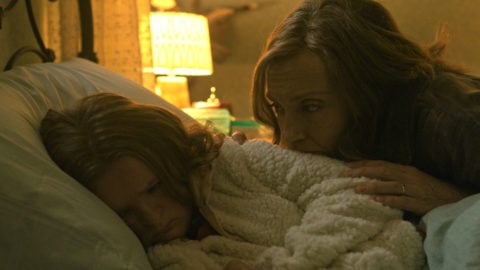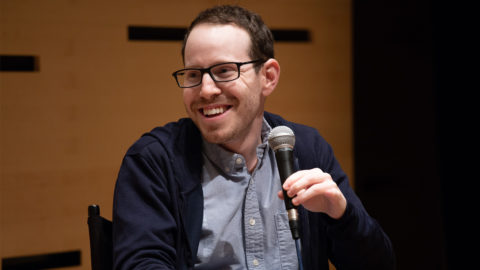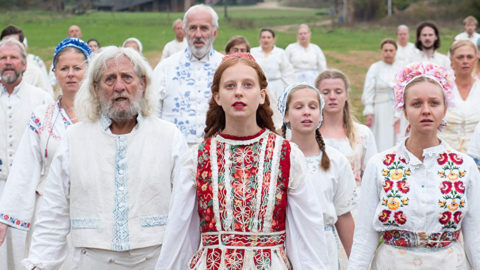Review: Midsommar
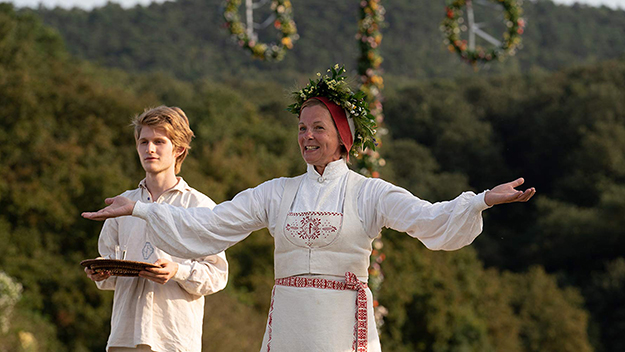
Images from Midsommar (Ari Aster, 2019)
Midsommar is a many-splendored—many-categoried—thing. Aesthetically, it’s sun-blanched, flower-child “daytime horror,” with a color palette seemingly borrowed from a Coachella photo spread. Narratively, it’s nordic pagan “folk horror,” where terror lies in the arbitrary irrationality of human social codes and cultural tribalism. Commercially, it’s the kind of glossy, conceptually ambitious, highly stylized “elevated horror” whose makers tend to self-reflexively emphasize the qualities that differentiate their work from “mere” genre cinema, and whose contours have been litigated by a certain kind of trend-hungry critical discourse for several years now. As in his first feature (last summer’s Hereditary), director Ari Aster has harnessed a singular mode of uneasiness in Midsommar that is cumulative and insidious: every setpiece is composed of precise, striking visual elements that are at once abstract and potently, primally suggestive.
The framing story is one of millennial relationship ennui: Dani and her boyfriend Christian are unhappily coupled, and a breakup is imminent. When a horrific family tragedy befalls Dani, the relationship tacitly shifts into a state of suspended animation, and she gratefully leaps at the chance to tag along with Christian and his graduate school friends on a boys’ trip they’ve planned to Sweden, as a means of getting distance from her intolerable new reality.
The destination is an idyllic farming commune, where the residents’ enthusiastic attunement to nature is coupled with attitudes toward the human life cycle that the American grad students find startlingly dystopian. When the visitors arrive, the community is about to begin celebrating a nine-day midsommar festival in honor of the solstice, to a lavish extent that apparently only occurs once every 90 years. Hallucinogenic drugs are liberally dispensed, accompanied by rigid protocols for communal dining and ritualized social engagement. The symbolic meanings and concrete implications of these traditions are never quite explicated, but a carefully accruing burden of generalized foreboding, paired with the vividly rendered and textured world-building effect of architecture and decor—starkly austere wooden barns and minimalist structures referred to as “temples,” all scattered across the bright grassy landscape—more than compensates.
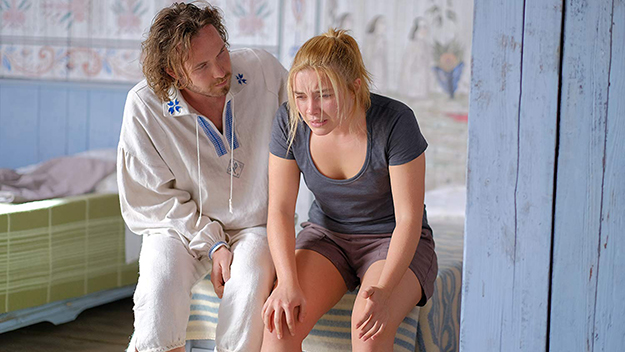
On Dani’s part, the sense of dread is existential, having more to do with her preexisting emotional state than with any of the off-putting behaviors that she and her companions witness in the Swedish countryside. The sickening extremity of her initial private trauma casts a shadow over the whole film, with such ambient intensity that not even the relentlessly saturated sunlight or the unflappably tranquil conviction of her very welcoming hosts can dispel its pall. As morbid angst give way to an overtly horrifying series of events, our protagonist’s preemptive alienation is formally consequential: if she’s already experienced the worst, then what are the narrative and generic stakes of her fear (and ours)? What exactly is she afraid of—which is to say, what does she have to lose?
As Dani, Florence Pugh carries the movie, and her wryly matter-of-fact commitment to the character’s tenuous subjectivity is what allows Aster’s storytelling to vacillate between blistering satire, broken-in psychological realism, and straight-faced ominousness, with a tonal dexterity and thematic sure-handedness that surpasses that in Hereditary. (Both of Aster’s films benefit from the strategies of boutique studio A24 which manages to cultivate a singularly cool air of buzzy anticipation around its singular filmmakers—a welcome approach at time when American mainstream cinema seems on the verge of system failure.)
The whole cast is infectiously game and temperamentally on point, but it’s Pugh who drives home the film’s central idea: that grief is foundationally destabilizing in such a way that salvation must be found not in the fallible intimacies of individual human relationships but in submission to the order-making rites and rituals of a social world—that is, initiation into a tribe. What’s terrifying in Midsommar is not the immense specter of loss that hangs over Dani, nor the strange and uncannily foreign logic of the commune’s traditions, but the very fact that Dani’s loss might have pushed her into a state of alienation within which that logic feels no more strange or foreign or uncanny than the newly unrecognizable home she’s left behind.
Madeline Whittle is the Programming Assistant at Film at Lincoln Center, and a freelance translator. Her film writing has appeared in Film Comment and The Brooklyn Rail.



